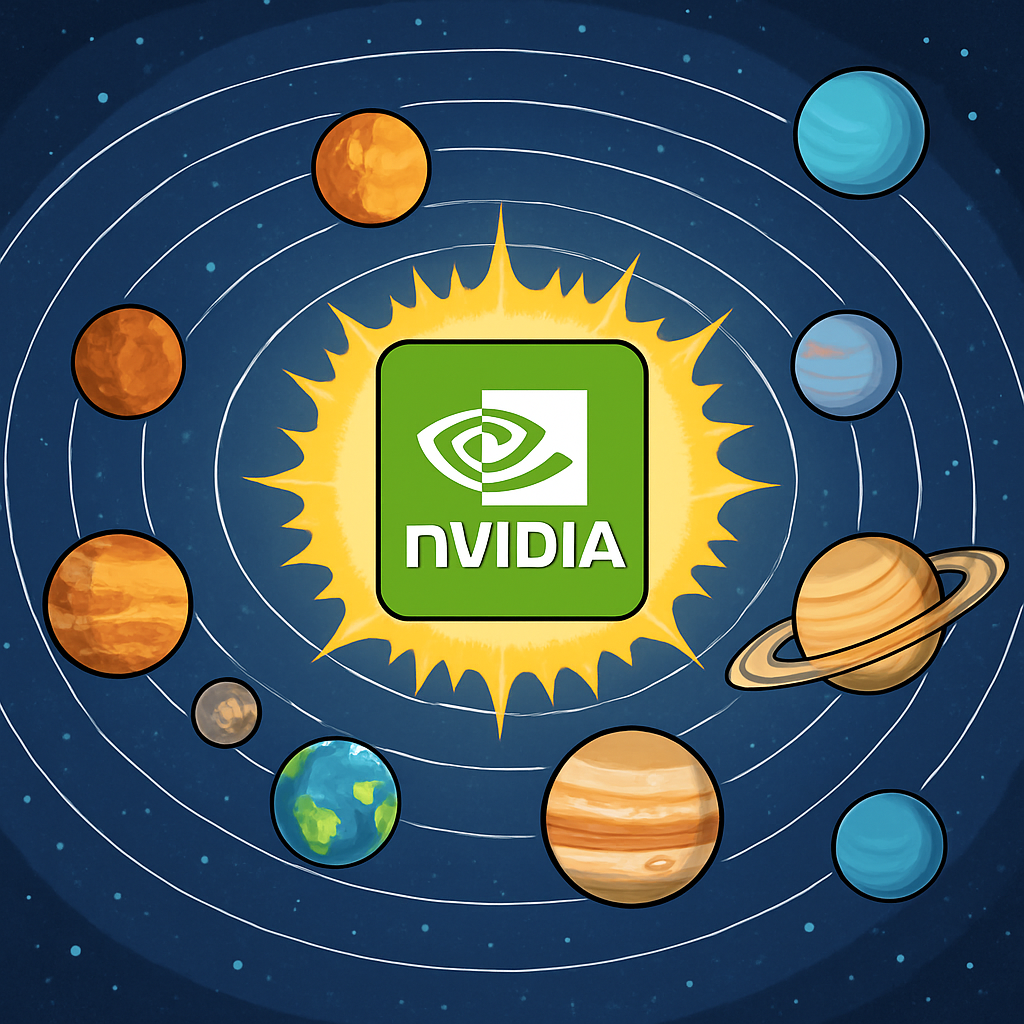
Markets doubted. NVIDIA answered. Here’s what the numbers say.
KEY TAKEAWAYS
-
NVIDIA delivered a blowout earnings quarter with $57B in revenue and strong margins
-
GPU demand remains structurally massive due to the shift toward generative and agentic AI
-
Bloomberg’s supply-chain data shows hyperscalers remain the core buyers driving NVIDIA’s growth. Hint: it’s the usual suspects 😉
-
AI skeptics were challenged as NVIDIA’s results proved the infrastructure side is thriving
-
Hyperscaler earnings going forward now determine the sustainability of the broader AI thesis
MY HOT TAKES
-
AI is not new; the scale of AI is what has changed
-
GPUs are now essential infrastructure, not optional hardware
-
The market has mispriced hyperscaler weakness relative to NVIDIA strength
-
The AI bubble narrative doesn’t survive real cash flow analysis
-
The transition from CPUs to GPUs is one of the biggest shifts in modern tech. Check that… it is THE biggest!
-
You can quote me: “NVIDIA didn’t report earnings; it issued a cease-and-desist to every AI skeptic on Wall Street.”
Unparalleled. As parallel processing continues to dominate data center and cloud growth–due to you know what (AI, lol 🤣)–it makes sense that a semiconductor company that has pretty much only made parallel processing solutions for most of its life continues to deliver unparalleled results. Let’s do one of my famous “let’s take a step back.”
Data centers, cloud computing infrastructure, and artificial intelligence are nothing new. That’s right, you heard right. On Wall Street, we have been using multiple forms of machine learning for many years. In the mid-2000s, I literally spent years developing and testing learning algos, as have many of my colleagues. Going beyond Wall Street, much of what we know today in search (like Google), social media (like Meta’s Facebook or even TIKTOK), or enterprise software (like Salesforce) has relied on various forms of artificial intelligence to do their thing. I am sure that you have heard a friend say: “the algos got me,” referring to how Facebook, Instagram, YouTube, or TIKTOK knows how to cue up content that is miraculously interesting to you based on what you recently eyeballed. That modern marvel is based on machine learning. Machines simply learn your habits. Scrolling fast through videos or thumbnails and you slow down and watch a few more seconds of one over the others–the “machine” takes note and discovers your habitual interests. When I say “machine,” I really should have said “machines,” as is in many servers. It takes lots of iron to make those connections.
Those machines, or servers, sit in cities of racks in data centers around the world. Amazon, not surprisingly, was a leader in data centers which it used to make its Amazon.com online retail second to none in e-commerce. Someone got the brilliant idea of renting out excess capacity from its data centers, and cloud computing evolved into a thing. Amazon runs the largest cloud computing infrastructure under its AWS offering. Looking into those servers we find microprocessors from Intel and Advanced Micro Devices (AMD). Those are very different from the ones offered by NVIDIA and that are being developed by many others. Intel and AMD have made and currently still make the bulk of their bread in CPUs while NVIDIA makes its bread in GPUs.
At the risk of oversimplifying, think of a classic Intel/AMD processor in a traditional PC or server as a brilliant single chef in a restaurant kitchen and an NVIDIA GPU as an army of line cooks. The CPU is optimized for doing a wide variety of complex tasks one after another very quickly–great at branching logic, operating systems, spreadsheets, and all the random nonsense we throw at our machines every day. The GPU, by contrast, is built to do a massive number of very similar calculations in parallel–originally to paint pixels on a screen, now to train and run AI models. So when you’re rendering a 3D world or pushing trillions of matrix multiplications through a large language model, the GPU cleans the CPU’s clock. But hand it your taxes or your email, and you still want that old-school Intel-type brain in charge.
Extending that into the data center and cloud, service providers and software developers are shifting their focus from traditional machine learning to a more advanced type of machine learning. The old models were like well-trained interns. You gave them a defined task, a clean dataset, and they cranked out predictions. Useful, yes, but narrow. The new era, generative and agentic AI, demands something entirely different: systems that can reason, plan, create, and adapt on the fly. And that kind of intelligence simply can’t be wrought out of a handful of CPUs grinding away in serial. It needs the brute parallel force of GPUs humming at full tilt, pushing through ginormous amounts of math every second. This is why the clouds are sold out, why hyperscalers are ripping out yesterday’s infrastructure, and why every serious AI workload today begins and ends on accelerated computing. Do you get the picture? Of course, you do. Now let’s step back forward.
NVIDIA is miles ahead of any competition in the space with a huge knowledge and intellectual property moat. Whether it was by plan or happenstance, NVIDIA has the right product for the right moment. A pivotal moment where there is an ongoing massive seachange in technology and productivity. That my friends, is why NVIDIA is the largest company on the largest–most followed–index the world over–The S&P 500. Because it is really at the core of the AI revolution, it has become the proxy for the future success of AI. And in case you haven’t heard, there have been some who question the viability of AI as an investment. No one is questioning how great the prospects are, but rather, whether or not the leaders in the space can continue to grow earnings to justify their high valuations and continued stock gains. In recent weeks all the companies that have become synonymous with AI have been under massive pressure despite continued earnings success and super-strong balance sheets. That is precisely why last night’s earnings announcement from NVIDIA was so highly anticipated. Watching the markets over these past few weeks, one could feel the tension building in NVIDIA.
Against that backdrop, last night’s NVIDIA earnings were not just good, they were a loud “told you so” for the GPU crowd. For the third quarter of fiscal 2026, NVIDIA printed about $57 billion in revenue versus roughly $55 billion expected and adjusted EPS of $1.30 versus $1.26. Data center revenue, which is at the heart of the story, came in around $51 billion, well ahead of consensus, with compute doing the heavy lifting and networking providing backup. Gaming, once the main engine, is now a respectable side hustle. Gross margins sat in the mid-70s and operating margin in the mid-60s. Folks, this is not a science project, it is a money machine.
Management then poured more fuel on the AI fire with guidance. They steered next quarter’s revenue to roughly $65 billion, and expect gross margins to drift even higher. They did this while assuming essentially no data-center compute revenue from China. On the earnings call, Jensen leaned hard into three overlapping transitions: from CPU to GPU-accelerated computing, from classical ML to generative and agentic AI, and from traditional data centers to “AI factories.” Check out this table and keep reading.

This is a snapshot of Bloomberg’s awesome SPLC (Supply Chain Analysis) screen for NVIDIA. On the right-hand side, the customers list reads like the AI Mount Rushmore: Microsoft, Meta, Amazon, Alphabet, Tesla, Dell, the OEMs and server makers. Bloomberg tags many of the biggest names as CAPEX buyers of NVIDIA. Those are the hyperscalers building “AI factories” for themselves and shoving tens of billions into GPU clusters. Further down are the COGS buyers like Dell, Lenovo, Foxconn, Gigabyte and Asustek. Those are the folks who buy chips as inventory and resell them inside boxes and solutions. The picture is simple: the hyperscalers fund the party, the OEMs serve the drinks, and NVIDIA owns the bar! 🍹
Glance one column to the right and you get the punchline. Many of those CAPEX buyers–the very companies naysayer investors have recently dubbed “AI bubble stocks”--have been under heavy pressure over the last three months. You see streaks of red next to Meta, Super Micro, and others even as NVIDIA’s own numbers look bullet-proof. Bloomberg deserves a shout-out here. Bloomberg’s supply-chain analysis doesn’t just show who buys from whom; it shows how concentrated that revenue is and how the market has treated the buyers versus the seller.
For the AI-bubble naysayers, this quarter should be humbling. The cash is real, the margins are real, and the demand is broad. But it does not let the hyperscalers off the hook. NVIDIA’s greatness is still a function of its customers’ willingness–and ABILITY–to keep writing enormous capex checks. Microsoft, Meta, Amazon, Alphabet and friends are the ones turning AI dreams into data-center steel and silicon. Jensen just handed them another quarter of proof that the infrastructure side of AI is working spectacularly. It is now on the hyperscalers to prove that their own earnings, not just NVIDIA’s, will eventually reflect the same kind of “unparalleled” math. Check out the following charts to get an idea of just how strong NVIDIAs earrings announcement was.


YESTERDAY’S MARKETS
Stocks gained yesterday, snapping a losing streak as investors prepped themselves for the gala event: NVIDIA’s earnings after the closing bell. Earlier in the session, the Bureau of Labor Statistics (BLS) bowed out of delivering its delayed October payrolls data which was a disappointment. The Fed’s FOMC minutes showed just how confusing the current macro environment is to policymakers, and just how divided they are on policy. The chilly feel of the minutes sent rate-cut prospects for December into the “unlikely” zone, but equities saw their way through it.

NEXT UP
-
Initial Jobless Claims (Nov 15th) is expected to come in at 227k.
-
Non-farm Payrolls (September) is expected to come in at 65k after a gain of 38k payrolls in August. Remember that this is lagging by 1 month!
-
Unemployment rate (September) is expected to be 4.3%, same as August. This is also lagged!
-
Existing Home Sales (October) may have grown by 0.5% after expanding by 1.5% in the prior period.
-
Fed speakers today include: Hammack, Barr, Cook, Goolsbee, Miran, and Paulson.
-
Important earnings today (it still aint’ over folks 😉): Bath & Body Works, Walmart, Jacobs Solutions, Gap, Intuit, and Ross Stores.
.png)

